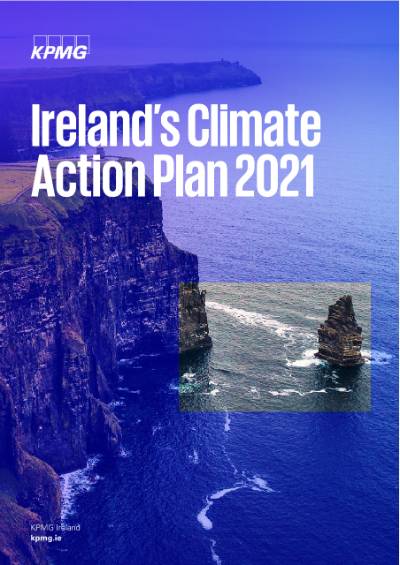The Climate Action Plan 2021 (CAP21) sets out almost 500 actions to support Ireland’s journey towards a 51% reduction in greenhouse gas emissions by 2030 (from a 2018 baseline) and carbon neutrality by 2050. The actions were proposed by all Government departments in light of the carbon budgets set by the Climate Advisory Council, and the legally-binding targets set out in the Climate Action and Low Carbon Development Act 2021. These targets are aligned with the European Green Deal.
Our Sustainable Futures team summarised the Climate Action Plan 2021 and its impact on citizens, communities and enterprise. It is broken down into seven sectors from the CAP21.
Summary of Ireland’s Climate Action Plan 2021
The scope of the plan is considerable. By 2030, the plan envisions large-scale renewable electricity generation, almost a million electric vehicles (EVs) on the road, retrofitting 500,000 homes to BER B2 or better, increasing the cost of emissions for industry and reducing chemical nitrogen usage on farms by 20%.
The CAP21 quarterly progress updates indicate that a greater rate of change is required to achieve these measures and to meet overall sectoral emission reduction targets.
The sheer breadth of the actions outlined in the Climate Action Plan highlights why the climate agenda is relevant to and will impact every single corporate in Ireland.

Keeping track of progress
The Climate Action Plan 2021 presents significant challenges to Irish enterprise. Looking ahead, quarterly progress updates will continue to be made available which will indicate the progress against the plan and highlight the areas of greatest opportunity.
Sector summaries

- Large-scale generation from wind is the primary focus, solar secondary.
- Increase flexibility of electricity demand (reduce demand when supply is lower).
- Implement schemes/grants for anyone to invest in renewable generation and sell back to the grid.
1. CO2 equivalent is a unit of measurement used to compare the emissions from various greenhouse gases based on their climate effects.

- Eliminate fossil fuels for heating buildings.
- Use more low-carbon materials in construction.
- Retrofit 500,000 homes and install 400,000 electric heat pumps.
- District heating - one large boiler to supply a geographic area.

- Increase rate of afforestation.
- Improve management and carbon sequestration of peatlands, grasslands and marine environments.
- Improve biodiversity in all biospheres.

- 845,000 electric vehicles on the road by 2030.
- Expand rail services; improve capacity and frequency of public transport; increase cycling investments, pedestrianise city centres.
- Reduce combustion engine vehicle kilometres.

- Increased cost of commercial CO2 eq. emissions (increased price of carbon and lowered ETS cap).
- Decarbonise heating in industrial processes.
- Provide grants through Enterprise Agencies.
- Support decarbonisation through new regulations.

- Reduce emissions from chemicals.
- Breed more efficient beef cattle and lower slaughter age.
- 5 x increase in land used for organic farming.
- Increase investment in R&D.

- Bioeconomy research, development and innovation grants available for businesses.
- Waste measures are focused primarily on preventing waste ahead of recycling and re-use.
- Increased regulation and research in the mineral exploration and mining sector.
Get in touch
If you have any queries on the above report or the impacts of Ireland's Climate Action Plan on your business, please get in touch with our team below. We'd be delighted to hear from you.


